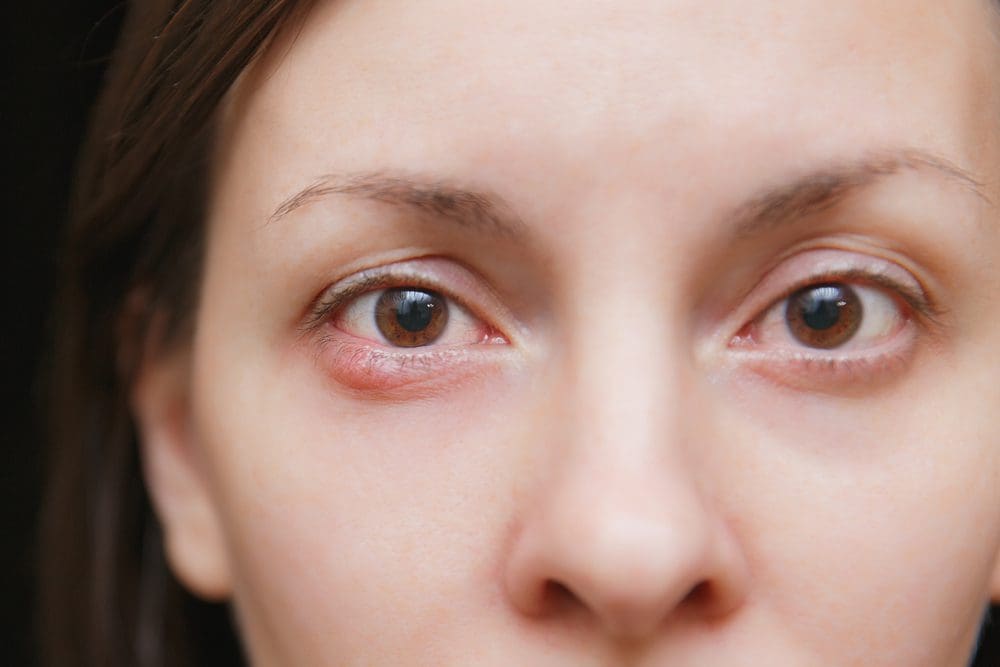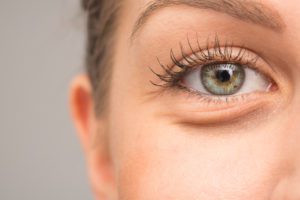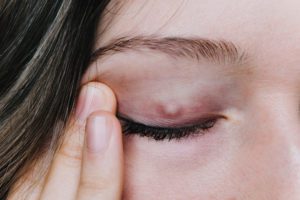How To Get Rid Of Bumps Under Eyes
Milia, styes, and chalazia are three types of bumps that occur under your eyes or on the eyelids. These types of bumps under the eyes are incredibly common, and most often, they can be easily treated.
Sometimes, these bumps may be referenced as chicken skin. Their white, pimple-like appearance resembles the skin of a chicken.
The bumps can be uncomfortable and look unattractive, but they are not always cause for concern. In some cases, bumps under the eyes can become increasingly painful and require medical attention.
Milia, styes, and chalazia can all be addressed with good eye hygiene, such as washing your hands and face regularly, and exfoliation. If they don't clear up on their own, you should visit a doctor for more intensive treatment approaches.

Bumps Under the Eyes
If you get bumps on the skin under your eyes, be aware that it's often a benign condition. Many types of bumps under the eyes, such as milia, are painless and relatively harmless. If you don't mind their appearance, you can usually live with milia until they clear up on their own.
Other types of bumps, like styes, can become very painful and should be addressed by a medical professional. While these bumps are not likely to threaten your vision, the bacterial infection could worsen over time if you don't seek proper treatment.
Maintaining proper eye hygiene promotes overall eye health and can help to limit these types of bumps. If you experience persistent and painful symptoms, they should not be ignored. Consult a doctor.
Milia Bumps
 Milia are small bumps that appear on the skin, often under the eyes. They are very common and typically not dangerous.
Milia are small bumps that appear on the skin, often under the eyes. They are very common and typically not dangerous.
These bumps are formed by keratin that is trapped under the skin. They can be white, yellowish, or skin colored. Some people call militia milk spots due to their whitish appearance. These bumps are small spots or cysts, and they are not a type of acne.
Styes
Styes are small, red bumps that grow under the eye. They form at the base of your eyelashes or underneath the eyelid.
Styes are typically caused by a bacterial infection at the root of the eyelash. They can become quite painful, especially as they swell.
 Symptoms of styes include:
Symptoms of styes include:
- A painful red bump at the base of your eyelashes.
- A spot of pus at the center of the bump.
- The sense of something being in your eye.
- Scratchy feeling in your eye.
- Sensitivity to light.
- Crusty eyelid.
- Tearing of the infected eye.
Anyone can develop a stye under their eye. People who have blepharitis and certain skin conditions, such as rosacea or seborrheic dermatitis, are at an increased risk for developing styes. Additionally, medical problems like diabetes increase the risk of styes.
It is important to seek medical treatment for a stye in order to treat the bacterial infection. An ophthalmologist can confirm you have a stye and then provide appropriate antibiotics to treat the infection.
If your stye is persistent and affecting your vision, surgical intervention may be necessary. Local anesthesia can be used to allow your eye doctor to drain the stye.
If a stye recurs, a biopsy may be necessary to rule out any underlying eye problems.
Chalazia
 Similar to styes, chalazia are small red lumps that form under the eye, in the eyelid. They are caused by blockage of an oil gland that then begins to swell. Unlike styes, a chalazion is not usually caused by a bacterial infection and rarely becomes as painful.
Similar to styes, chalazia are small red lumps that form under the eye, in the eyelid. They are caused by blockage of an oil gland that then begins to swell. Unlike styes, a chalazion is not usually caused by a bacterial infection and rarely becomes as painful.
Symptoms of chalazia include:
- A red, tender, swollen bump on the eye.
- Tearing.
- Mild eye irritation.
- Blurred vision, when the chalazion is large enough.
Chalazia occur most commonly in adults, although children can get them. Most frequently, chalazia occur in people between the ages of 30 and 50. People with pre-existing conditions, such as acne rosacea, blepharitis, seborrhea, tuberculosis, and viral infections, are more at risk for developing chalazia.
Fortunately, chalazia typically clear up on their own within a few weeks or a month. They usually don't require medical treatment, though they can be recurring.
Treatment of chalazia is focused on applying warm compresses to the eyes and gently massaging the external eyelids in order to promote proper drainage of the oil glands.
How Do I Treat the Bumps?
While you can attempt to self-diagnose bumps under your eyes, there is a chance you won't identify the bumps correctly. This is why it's generally best to see a doctor to confirm your suspicions.
At-home measures, such as applying warm compresses and following proper eye care hygiene steps, can promote general eye health.
Ophthalmologists and dermatologists stress that patients should not attempt to "pop" or squeeze milia, styes, or chalazia. Doing so can damage the skin, increase your risk of infection, and cause scarring.
When to See a Doctor
If the bumps under your eyes get worse or do not heal within a month, you should contact an doctor. Seek care from an eye or skin professional to receive a correct diagnosis and receive proper treatment for the problem.
FAQS
-
Can I wear makeup to cover the bumps?
Depending on the type of bumps under the eye, you can sometimes apply makeup to camouflage them for work or social engagements.
If you have a stye or chalazia, you should ideally not apply makeup to it. If you can take a break from eye makeup until the area heals, this is the best approach.
Eye makeup can carry bacteria and spread a stye to the other eye. If you have to apply makeup for a particular engagement, use a non-comedogenic makeup that won't clog your pores. And clean your makeup brushes thoroughly before and after applying to ensure you aren't spreading bacteria.
You can cover milia with makeup, but it's best to use oil-free varieties to avoid further clogging pores. Try to avoid anything heavy in the area.
-
How can I prevent milia under the eyes?
The best way to prevent milia is to fully cleanse your face daily, paying particular attention to the area under your eyes. Make sure to fully remove makeup.
Don't use oily eye makeup removers, which can trigger milia. This is because they often leave oily residue under the eyes.
Gently exfoliate under your eyes. This can greatly reduce existing milia and prevent future problems.
Talk to your dermatologist about the best serums, creams, or lotions to use in the area. Some doctors recommend incorporating retinol or AHA or BHA exfoliators into your routine. Generally, you should stay aware from heavy creams.
References
Chalazion. American Optometric Association.
Milia. (March 2017). Medscape.
What Are Chalazia and Styes? (August 2019). American Academy of Ophthalmology.
What Are Milia — And How to Get Rid of Them. (August 2018). USF Health, Dermatology & Cutaneous Surgery.
Chalazion. Cleveland Clinic.
Here's How to Wear Makeup With a Stye. (April 2016). Bustle. Milia: What They Are, and How to Remove Them. (October 2017). Teen Vogue.
#SkinSchool: Milia Causes and Treatment Options. (January 2021). Harper's Bazaar.
The information provided on this page should not be used in place of information provided by a doctor or specialist. To learn more, read our Privacy Policy and Editorial Policy pages.
How To Get Rid Of Bumps Under Eyes
Source: https://www.nvisioncenters.com/eye-health/bumps-under-the-eyes/
Posted by: staleywallst.blogspot.com

0 Response to "How To Get Rid Of Bumps Under Eyes"
Post a Comment